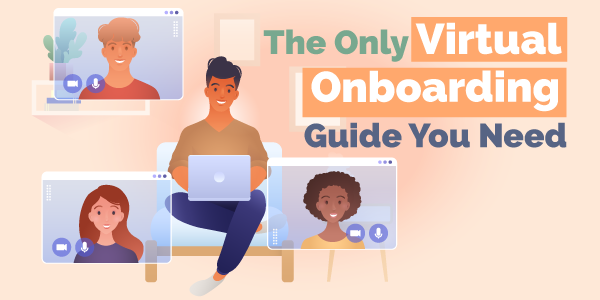
It’s been more than a year since the 2020 pandemic turned our lives upside down. Within that period, we’ve made considerable progress in coping with challenges and living in the “new normal.” So even though we’re still in the middle of the pandemic, we can manage to get back on track with our day-to-day affairs with a little bit of everything: flexibility, creativity, tenacity.
And so, it’s business as usual for many companies. These firms have decided that there’s no more delay in helping the business recover, so they have resumed operations under the new normal.
One of the solutions that companies have come up with in these extraordinary times is virtual onboarding. Since there’s still limited physical movement allowed and on-site gatherings are prohibited, HR departments and their recruitment agency are onboarding remote employees virtually.
Through virtual onboarding, companies can ensure that they remain in full gear while protecting new employees before they could even meet their coworkers. What goes on in virtual onboarding programs may vary from one company to another, but we’ve come up with a guide that will allow you to do it like a pro.
Know the essentials of virtual onboarding with this infographic.

What Is Virtual Onboarding?
Onboarding refers to the process of helping new employees fit in with your company. It’s different from a single-day induction or orientation event because onboarding is a more multifaceted process. Onboarding includes welcoming and introducing new hires to the team, educating them about the company and their role in it, and providing the tools they need to get them up to speed.
There’s no fixed timeline as to how fast or long the employee onboarding process should take, but since it’s a company-wide initiative that involves management and new and old employees, an onboarding program may last up to 12 months.
Pro tip: If you think you can fit all induction, orientation, and onboarding activities in a day, focus your mindset on the process, not the event.
While onboarding may be something you’ve been doing for years, virtual onboarding is a different matter. Obviously, there’s no opportunity to shake hands or greet one another in person as you welcome new-hires into the company. It’s also not possible to give new employees a tour of the office or let them see where every team fits into the organization.
Thankfully, you can tap digital technologies like email, chat with text and video, and other online work platforms to do virtual onboarding as if you’re just next door or in the same office building as the new hires. Not only do these tools compensate for the limitations that come with the absence of on-site orientation, but they also complement your HR’s existing onboarding programs.
This brings us to our next point: You need a checklist of must-haves and to-dos when getting new employees on board.
Virtual Onboarding Checklist
A virtual onboarding checklist will help you keep track of the many moving parts involved in helping new employees acclimatize to your company. At the same time, a checklist ensures that you don’t get sidetracked as you get busy with other projects or when newbies start demonstrating some competency.
Here’s a rundown of things to include in your virtual onboarding checklist:
- Virtual onboarding map – This will lay the foundation of the entire onboarding process. Use it to identify, organize, and monitor the tools and systems that new employees need as they start working until they fully assimilate their role in the company.
- Orientation schedule – Depending on the duration of the onboarding process, your orientation schedule may contain a timeline of activities spread across a weekly, monthly, quarterly, or semi-annual basis.
- Channels of communication – For easier communication and collaboration with the new members, they should be added to the company’s communication channels like the intranet, messaging apps, and email groups. You’ll need help from your IT department to ensure that log-in credentials are issued before their start date.
- Mentors – New employees could use the help of a virtual mentor who would work closely with them so they won’t feel neglected or ignored. The designated mentor could be a senior member of the team who can share valuable tips and advice to newbies, including who to contact when they need help on specific projects.
- Pre-recorded instructional videos – These e-learning videos should walk through new employees on key information about the organization: company history, organizational structure, an overview of teams or departments, workflows, product and services, and so on.
- Welcome care package – This could be a collection of work-related documents in PDF, a link to training videos or webinars, or even welcome messages from the team—all sent electronically. You could even have branded stuff or free goodies delivered to your new employees to build goodwill or help them with first-day anxieties.
Best Practices and Tips for a Successful Virtual Onboarding
The first day is a critical time to make a good impression on your new employees. Statistics show that 69% of employees who experienced an optimized onboarding process are more likely to stay with that company for three years. Therefore, it can spell the difference between having highly engaged and productive employees and struggling to retain talented people in your organization.
With that said, you need to design an onboarding program that focuses on a positive experience of learning and alignment in a virtual environment. Here are some things to keep in mind:
1. Be proactive and creative with pre-boarding
Pre-boarding is the time between a job applicant accepting your job offer and his/her first day on the job. Use it as an opportunity to get all the paperwork done, signing benefit forms, shipping the company laptop, and briefing the employee on what to expect come onboarding time.
It also pays to briefly introduce the new employee to the team manager and other members in a fun, getting-to-know-you virtual event.
2. Build personal connections
Once the new employee has been introduced to the team, it may be a good idea for the manager to name the new hire’s work buddy. This practice can provide direct and immediate support to the newbie who’s probably feeling unsure about many things and can use someone’s expert guidance.
3. Discuss the job role and expectations
Employee surveys reveal that among new-hires, 44% left within the first six months because they were not given clear guidelines about what’s expected of them.
To ensure that new employees understand their job roles and responsibilities, assign them tasks that they actually need to work on over a set period of time. It’s a good opportunity for them to acquire specific skills and, at the same time, provide you with initial feedback on the style or quality of their work.
4. Explain the company culture and values
For newbies, the first several weeks or months are vital as this is the time to actively learn more about their job and coworkers. They should receive adequate support from managers and work buddies by answering their questions, giving them feedback, and including them in the company culture.
5. Practice the 3 Cs = Clear, concise, and consistent
Did you know that, on average, new hires have to complete more than 50 activities during onboarding?
It can be daunting for new employees to focus on their onboarding goals if they’re getting conflicting information from the people training them. HR, team managers, and mentors need to work together to ensure that they’re all on the same page to be a credible support system for new employees.
If the manager or mentor isn’t available on some training days, another person from the team or HR should step in to assist.
6. Set casual video calls
In traditional onboarding, it’s easy to gather new employees and engage them in a quick huddle to ask them how they’re doing so far. Virtual onboarding can be more challenging.
Meetings through video calls can fill in new employees on what’s happening at the company, and they can also be a quick touchpoint to stay connected with the team. When it comes to onboarding, casual video calls can go a long way in reminding new employees that they belong to a team and are not left to work alone.
What Good Virtual Onboarding is About
Putting yourself in the shoes of a new hire, anticipating and understanding the challenges of remote work, getting the whole team on board—these are important aspects of onboarding that you should focus on to make the experience as effective and engaging as possible for everyone.













